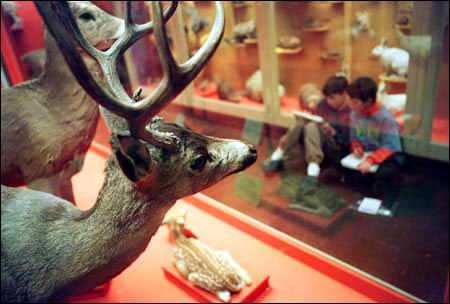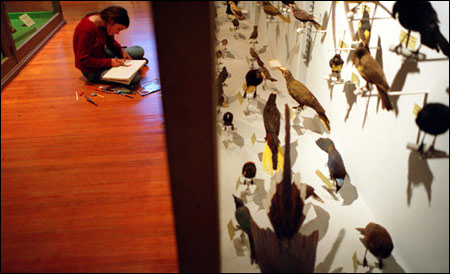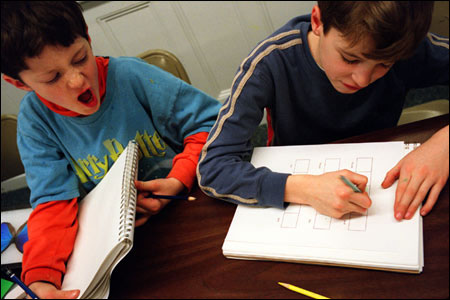Local kids learn contour, shading, zoology :
Harvard Museum of Natural History program blends art, science, and community children

“Who has blue?”
The question started the horsetrading for the colored pencils as a group of schoolchildren age 8 and older began their art lesson for the week.
The next sessions of Animal Artists meet March 4-April 8 and April 22-May 27. Each session meets for six Tuesdays from 3:40-5 p.m. The fee is $90; $81 for members. Sign up for two or more classes and get an extra 10 percent off. See Calendar for more information on museum classes.
Their instructor, Erica Beade, patiently explained that everyone had the same pencils, blue and yellow, and, indirectly, green.
Beade talked the children through an exercise where they blended yellow and blue to make green, and then changed the proportions to make a different shade of green. She talked about crosshatching and building up lines as ways to give a drawing depth and then went on to talk not about art, but about insects.
“What’s an insect?” Beade asked.
“They’re gross, disgusting, another name for a bug,” said David Salmon, one of seven in the class.
“Are they warm-blooded or cold-blooded?”
“They don’t have blood,” came the answer.
Blood or not, insects are just part of the natural world being explored by children in a six-week after-school program called Animal Artists that blends art and science at the Harvard Museum of Natural History (HMNH). Beade, a scientific illustrator whose work has appeared in Massachusetts Audubon’s Sanctuary magazine, has taught the class for the last year and a half. She usually spends half the class going over drawing techniques, such as shading and color, and includes a lecture on some aspect of natural history. Then she sets the kids loose in the zoological galleries to draw whatever strikes their fancy.

During a recent class, the children dashed about a bit looking for a drawing subject, and then settled onto the floor to draw, singly, or in little knots of two or three.
For Haylee Herman-Hesse, her fancy that day was wolves. Though the curriculum has remained roughly the same for each session, Herman-Hesse has been back for four or five sessions. She said she loves to draw animals and her drawing has improved a lot from her time at the program.
“I like wolves and horses and I can’t choose between them,” Herman-Hesse said.
Though the setting may seem unusual for an art program, HMNH Education Director Pete Money said art and science have been linked for centuries.
“It’s a perfectly natural marriage of things,” Money said. “Art and science have been hand-in-hand for hundreds of years.”
The Animal Artists program is part of an active community education program that draws thousands of children to the museum each year and includes school field trips, after-school programs like Animal Artists, and Saturday morning and summertime science programs.
“It’s our alternative to Saturday morning cartoons,” Money said.
Beade said she enjoys teaching the class because the blending of art and science reflects her own interests.
“These are my two passions, nature and art. Doing scientific illustration puts them together,” Beade said. “It’s the kind of class I would have liked to take when I was a child.”
Share this article





